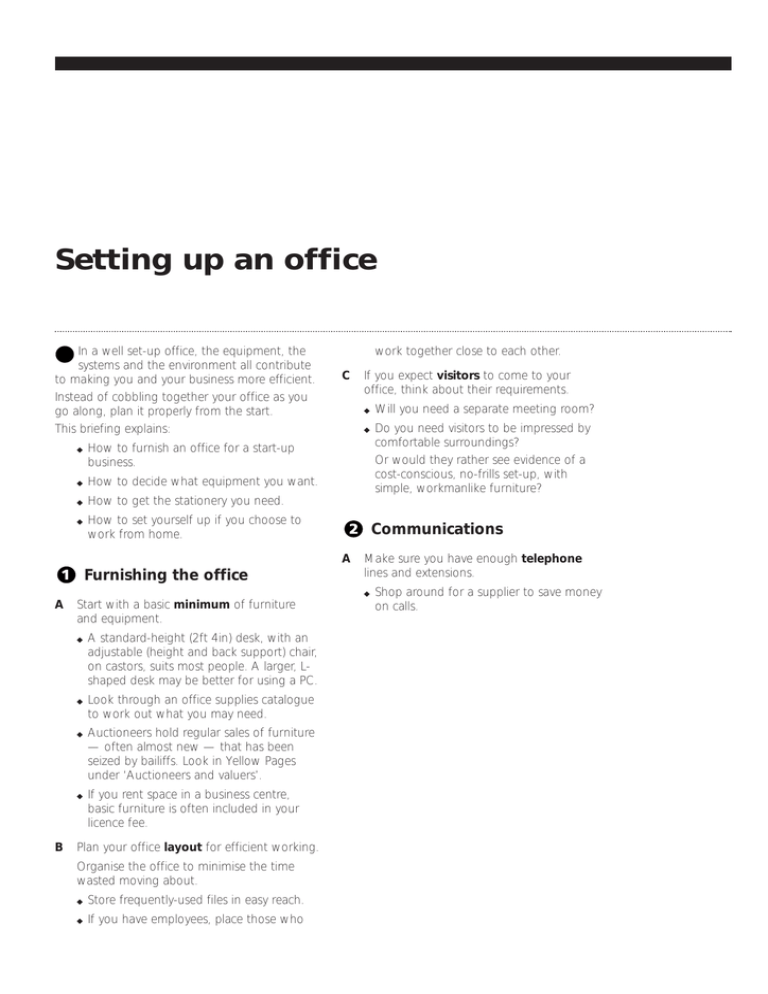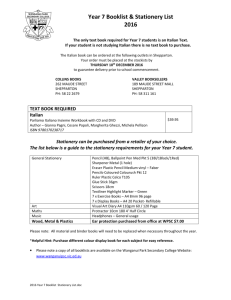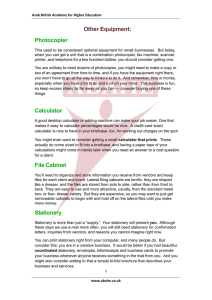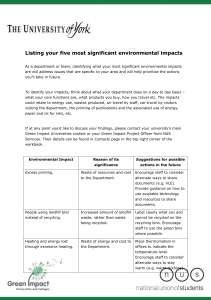Setting up an office
advertisement

Setting up an office In a well set-up office, the equipment, the systems and the environment all contribute to making you and your business more efficient. Instead of cobbling together your office as you go along, plan it properly from the start. This briefing explains: ◆ How to furnish an office for a start-up business. ◆ How to decide what equipment you want. ◆ How to get the stationery you need. ◆ How to set yourself up if you choose to work from home. Furnishing the office work together close to each other. C If you expect visitors to come to your office, think about their requirements. ◆ Will you need a separate meeting room? ◆ Do you need visitors to be impressed by comfortable surroundings? Or would they rather see evidence of a cost-conscious, no-frills set-up, with simple, workmanlike furniture? Communications A Make sure you have enough telephone lines and extensions. ◆ A Start with a basic minimum of furniture and equipment. B ◆ A standard-height (2ft 4in) desk, with an adjustable (height and back support) chair, on castors, suits most people. A larger, Lshaped desk may be better for using a PC. ◆ Look through an office supplies catalogue to work out what you may need. ◆ Auctioneers hold regular sales of furniture — often almost new — that has been seized by bailiffs. Look in Yellow Pages under ‘Auctioneers and valuers’. ◆ If you rent space in a business centre, basic furniture is often included in your licence fee. Plan your office layout for efficient working. Organise the office to minimise the time wasted moving about. ◆ Store frequently-used files in easy reach. ◆ If you have employees, place those who Shop around for a supplier to save money on calls. ◆ B Pages. Shop around, especially for bargains in secondhand extension phones and small business phone systems. Email is cheap and fast and lets you send and receive messages at any time. ◆ ◆ C If you decide to work from home, think about swapping your home phone line for a business line. It also allows you to send any sort of computer file as an attachment. As well as word-processed documents, you can transmit diagrams, photographs, spreadsheets and software. In many industries, customers and suppliers will routinely expect to contact you by email. A fax machine allows you to send information quickly and efficiently to customers and suppliers. ◆ Office equipment The time saved by having the right equipment in your office will more than justify the cost. A Most start-ups find that a computer system pays for itself within a year, even if it is only used for word processing, some spreadsheet work and storing a simple contacts database. See Setting up your first IT system, SuB 25. B Most fax machines can also be used for basic photocopying. Many small businesses can just use the fax for everyday copying, and use photocopy shops for large numbers of cheap copies (usually 4p to 8p per A4 copy). The cheaper fax machines, costing £100 or so, use the more expensive thermal paper, which fades and may become unreadable. Better machines, using plain paper, cost from around £300. D There are several options available when it comes to acquiring communications equipment. ◆ Most types of equipment can be bought, rented or leased. ◆ Suppliers can be found in the Yellow If you need a photocopier, choose one to suit the expected copying workload. ◆ Copier prices start at around £375, though machines are often leased, rather than bought. Prices start at about £25 a month for a three-year lease. ◆ Maintenance charges are around 2p a copy all in (including toner powder) for smaller machines and up to 2,000 copies a month, falling to 1p per copy for volumes of over 5,000 copies a month. Watch out for expensive maintenance commitments, buyout clauses and minimum usage contracts. ◆ Check the number of copies a minute the machine can make. This is shown in the manufacturer’s brochure. Ask for written confirmation of the number of copies a month it is designed to handle, and of its expected lifespan. ◆ Features you may want include reduction and enlargement, the ability to use A3 paper, and automatic paper handling for multiple sheets. Being available Being contactable is essential for start-ups. Consider the range of services and devices you can use to ensure you can always be reached. ◆ ◆ ◆ A mobile phone allows you to be contacted at all times. Call charges can mount up, but there is a range of tariff structures, including pre-pay deals, to suit most businesses. Call waiting alerts you during a call if another caller is trying to reach you. You can switch from call to call and back. Call waiting costs about £6 a quarter. Call diversion lets you redirect incoming calls. There will be a standard charge plus the cost of the diverted calls. ◆ An answering machine is simple and cheap (£20 to £150), but many callers do not like leaving messages. ◆ An answering service will take calls and pass messages on. Some services will answer calls in your business name. Regularly test the service by leaving messages for yourself. C You may be able to save time and money by investing in basic postal equipment. ◆ Buy a set of postal scales, to avoid frequent trips to the post office. ◆ A franking machine saves fiddling about with stamps by automatically stamping your mail. Rental costs are between £5 and £15 a week. Royal Mail can give you the names of recommended suppliers. ◆ If you use stamps, keep them in an indexed (1p, 2p, etc) stamp book. page 2 D A dictating machine can be a cheap and efficient way of recording information. centres provide office equipment for a higher licence fee. A dictating machine costs £25 to £100. A playback machine, to help transcribe your tapes, will cost from £250. E A scanner with optical character recognition (OCR) software can save hours of work, if you routinely need to re-type large volumes of text into your computer. ◆ ◆ OCR allows the scanner to read text off a page and capture it in a computer file suitable for word processing or other uses. Good on paper Your stationery is an important factor in creating your business image. A All your stationery should have the same overall style, with matching typefaces, design and paper — or card — quality. Choose a flatbed scanner (about £120) which is fast, with high resolution and a good OCR software package. Test the model you are thinking of buying, by trying it out on a document that is typical of your workload. Before buying any item of office equipment, consider whether you would be better off using an outside service. Some business Choose a clear, easily-read typeface. ◆ Paper weights range from 80 gsm (grams per square metre) to 120 gsm. Card varies from 180 gsm to over 300 gsm. Is heavy, ‘quality’ stationery important for your image? ◆ A recognisable logo, or a slogan, can help to build up your company image. But these are not necessarily high priorities for most start-up businesses. A good printer or designer will be able to advise you and show you samples of previous work. Stationery costs A The cheapest option is to laser print or photocopy your stationery. ◆ B Once you have the design for your letterhead, you pay only for the paper — say £3 a ream (500 sheets) for medium-quality A4 — plus the cost of photocopying or laser printing. Letterhead stationery (A4 size) is used for letters to customers and suppliers. ◆ Include your business name, address (including postcode), phone and fax numbers and email and website addresses. ◆ By law, you must include names of the sole trader or of all the partners, or the full company name — unless this is the same as the business name. A limited company can add either all or none of the directors’ names. ◆ A limited company must show the registered number, the registered office address and the country of registration. ◆ Businesses registered for VAT must show their VAT number on invoices. However, your stationery will lack the quality and image of professional printing. B Many printers offer business ‘starter packs’. Prices range from £50 to over £300. A typical start-up might spend £100 for 200 letterheads, 200 compliments slips, 200 business cards and 200 two-part invoices. C For complete flexibility, find a print shop or commercial printer to work to your specification. Prices vary around the country, and also depend on quality. The larger the order, the lower the cost per sheet will be. ◆ Typesetting might cost £30 to £50. Special design work (eg producing a logo) will cost more. ◆ A4 paper prices range from £3 to over £18 a ream. ◆ Printing black letterheads might cost £50 for the first 500, plus £20 for each extra ream. Printing in one colour, other than black, adds a further £20 to £40 to the total cost. C Compliments slips are a cut-down version of your letterhead, giving all the basic information (but omitting details like registered office) on a smaller piece of paper — usually the same width, but one third the depth. They are useful — and economical — for sending brief messages and cover notes. D Invoices, receipts and statements may be needed by the handful or by the hundred, depending on your business. If your business only issues these occasionally, you can use your letterhead paper, with an appropriate heading inserted below the letterhead. page 3 ◆ E Alternatively, have your name, address and VAT number (if registered) printed on labels or incorporated in a rubber stamp and use standard duplicate stationery. Business cards give customers, suppliers and other contacts a record of your name and details. ◆ Use a standard card size. ◆ Your name (including first name) and job title (eg managing director) should be given prominence. You may want to add any relevant qualifications. ◆ If appropriate, include your numbers for your direct telephone line and mobile phone, and your personal email address. ◆ Include the business’s name, address, telephone and fax numbers and email and web addresses. Outside working hours, give family and friends your full attention. C Will working from home provide the right image? ◆ Do you expect visitors to come to your office? What will they think? Could you arrange to visit their premises or hire a meeting room instead? ◆ Will your address be suitable? Should you use a mailing address? Business centres often offer a ‘virtual office’ facility, receiving post, telephone calls and faxes on your behalf and then forwarding them on to you. D What are the financial implications? ◆ An appropriate proportion of bills (eg electricity) can be treated as business expenses and offset against tax. There may be other tax implications. Ask your accountant for advice. ◆ Unless you claim mortgage payments or rent against tax, you should not usually be liable for uniform business rates (UBR). If part of your property is used wholly or mostly for business, you may be liable. ◆ You must tell your insurers you work from home (and change the insurance on your car, if you use it for business). Otherwise, your insurance may become totally invalid. ◆ You may be required by law to take out public liability insurance. If you employ people — even part-timers — employer’s liability insurance is compulsory (see Insurance, SuB 26). Business cards in black ink cost £30 to £60 for 500, depending on the card used. For temporary business cards, try a vending machine (often available at some railway stations), or print them yourself onto perforated business card blanks. Working from home Many small start-ups find setting up an office at home the most attractive option. It is cheap and handy, but there may be drawbacks. A Is it legal? It should usually be possible to use part of your home as an office. (See Forming a business, SuB 2.) B Will it provide the right working environment? It can be difficult to discipline yourself to be productive. ◆ Take yourself seriously. Even if you work only a few hours a week, remember you are running a business. ◆ Establish a work space. It will be easier to concentrate on work once you enter the work space, and to switch off when you leave. ◆ Separate ‘at work’ from ‘home’. Discourage social phone calls and domestic interruptions during your working day. ◆ Arrange your work patterns to fit in with the family and set working hours during which you are not to be disturbed. page 4



